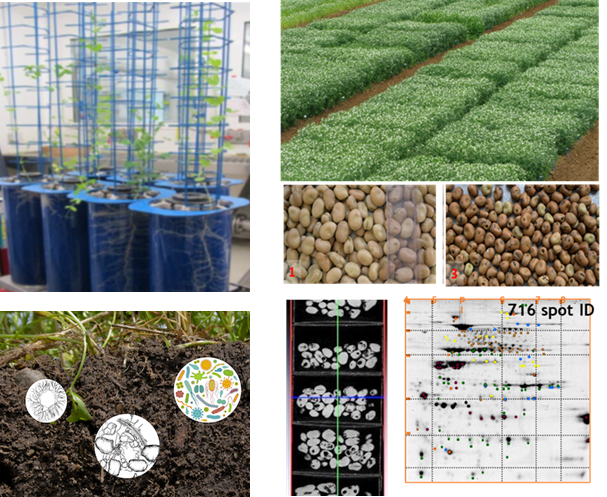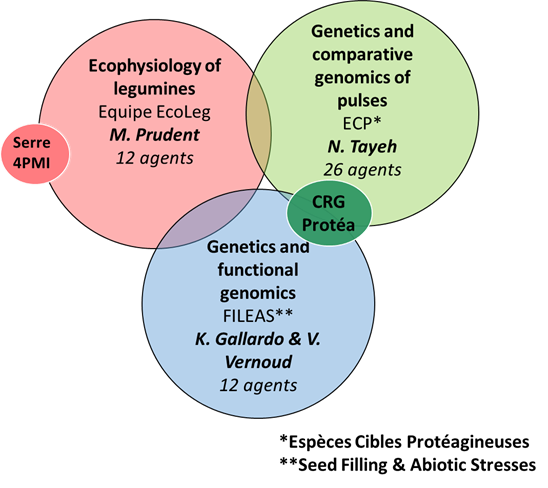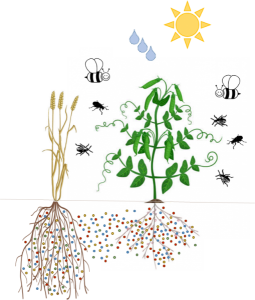Pôle GEAPSI
Responsable : Judith Burstin
Directeur de Recherche INRAE
Tél : 03.80.69.21.59
judith.burstin@inrae.fr
Context
The group ‘LEGae’ for Legumes Ecophysiology and Genetics for agroecology (Resp. J. Burstin), studies the Genetics and Ecophysiology of grain legumes for agroecology and food via a multidisciplinary approach (genetics, ecophysiology, molecular physiology). The objective of our work is to promote agro-ecological and food transitions by contributing to the development of grain legume crops in France and Europe
Tasks
Our research aims to:
• Understand the functioning of grain legumes in the context of climate change in fluctuating hydro-mineral conditions;
• Characterize the genetic diversity and environmental plasticity of the nodulated root system of legumes, and its interactions with rhizospheric micro-organisms;
• Understand the mechanisms that govern the development and quality of legume seeds for human and animal nutrition;
• Contribute to pre-breeding through (i) high-throughput phenotyping and translational genomics approaches, (ii) the exploitation of genetic resources and (iii) the development of genetic and genomic tools.
LEGae manages the INRAE Conservatory of Seed Legumes Genetic Resources (CRB PROTEA) and is involved in the development of the High-throughput phenotyping platform for plant-microorganism interactions (Serres-4PMI).
Strategy
The challenge of our research is to design ideotypes of legumes that could serve as levers for developing biological regulations and cropping systems that are more frugal in terms of inputs and that are sources of plant proteins and quality nutrients. The scientific challenges are to acquire knowledge on the genetic and physiological determinants at the basis of the adaptation of grain legumes to agroecological cropping systems and involved in the control of the nutritional, organoleptic and technological quality of the seeds.
To meet these challenges, the LEGae cluster is structured into 3 research teams:
• ECP: Genetics and Genomics of Protein Target Species (Resp. N. Tayeh)
• EcoLeg: Ecophysiology of legumes (Resp. M. Prudent)
• FILEAS: Seed filling, NS remobilization, and end-of-cycle abiotic stress (Resp. K. Gallardo & V. Vernoud).
We use approaches that range from field and controlled conditions experimentation to ecophysiology, biochemistry, "omics", bioinformatics, forward and reverse genetics, and up to breeding innovation and crop models. We interact with other disciplines (microbiologists and microbial ecologists, agronomists, pathologists, climatologists, biochemists, nutritionists, technologists).
Current projects
In June 2023, LEGas is involved in 26 scientific projects.
LEGae leads several national projects as coordinator.
• SPECIFICS (2021-2027) Sustainable PEst Control In Fabaceae-rich Innovative Cropping Systems (PIA3, ANR, coord. J. Burstin & S. Cordeau). Partners: UMR Agroecology, UMR IGEPP, UMR LEVA, UMR AGIR, UMR IRHS, URGI, UE Epoisses, UE Bourges, UE La Motte, UMR BioEcoAgro, UMR LISIS, UMR9221 IESEG. Design cropping systems without pesticides and rich in grain legumes using different levers: identification of new sources of resistance, design of systems with more biological diversity in time (rotation) and in space (intra- and interspecific intercropping , agro-ecological infrastructure, etc.), identification of solutions for enhancing and promoting these systems.
• LETSPROSEED (2023-2028) Increase the consumption of legume proteins by improving their quality and processing without compromising resistance to stress (ANR, coord. K. Gallardo). Partners: INRAE (UMR Agroecology, CSGA, IJPB, UR BIA, UMR PhAN, UMR STLO, IPS2, UMR SPO/PROBE-PFP), Univ. Angers (UMR EVA), The Agro Institute Dijon (UMR PAM), TERRES INOVIA, AGRI OBTENTIONS, TERAXION (VIA VEGETALE), SOREDAB, BEL, DANONE. Production and quality of seeds, transformation of proteins, development of ingredients based on legumes, functionality, nutritional and organoleptic properties, presence of allergens and health effects.
• PIVERT (2023-2026) Removing off-flavor components from pea seeds by genetic means (ANR, coord. V. Vernoud). Partners: Agroecology (FILEAS, ECP), UMR SVQV, IPS2, CSGA. Mobilizing the genetic lever to reduce the green taste of pea seeds.
• BLACKBOX (2022-2025) Open the black box of the interaction between soy and soil microbial communities (LIA A-AGD, coord. M. Prudent). Partners: Agroecology (EcoLeg), TIMAC Agro, CAU Beijing. Hydromineral nutrition of soybeans under thermal and water stress conditions, and in interaction with microbial communities.
LEGae is involved in international projects:
• ROOTED (2023-2026) Root Phenotyping Integrated Educational Doctoral Network, Horizon Europe, Coord. S Tracy (University College Dublin, Ireland). Partners: UC(IE), FZJ (DE), UT (EE), WU (NL), AU (DK), UFZ (DE), UCLouvain (BE), NIAB (UK), UB (FR), UON (UK) ), MLU (DE), BIOE (IE), DLF (DK). Role of root architecture in the hydro-mineral nutrition of pea under mineral or water stress conditions.
• BELIS (2023-2026) Breeding European Legumes for Increased Sustainability, Horizon Europe, Coord. B. Julier (INRAE Lusignan); 35 European partners. BELIS' ambition is to increase the profitability of plant breeding, measured by the genetic gain per breeding cycle and its sustainability.
Contribution to the axes of the UMR project
Axis “Biodiversity and biotic interactions in a changing environment”
Our contribution aims to understand biotic interactions and determine new selection targets at population and community levels to optimize biological functions and ecosystem services in a changing environment.
To do this, we work to identify the genetic, molecular and ecophysiological determinants (i) of the functioning of the interactions between legumes and rhizospheric microbiota, (ii) of the resilience to water, thermal and nutritional stresses of plants, in connection with the rhizospheric microbiota and seed quality, (iii) interactions between legumes and bruchids, sitones, and pollinators, in connection with the evolution of pest and beneficial populations under agroecological conditions, (iv) stand performance multi-variety or multi-specific, in agro-ecological conditions.
Axis "Transitions towards sustainable and multi-performing agricultural systems"
Our work aims to contribute to the development of agroecological cropping systems, rich in grain legumes, by improving their competitiveness.
To do this, we develop, optimize and share tools and resources that contribute (i) to the creation of high-performance varieties of grain legumes (peas, beans, lentils), (ii) to the definition of ideotypes of grain legumes (species/varieties and cultivation techniques) adapted to current and future pedoclimatic contexts in France and Europe, and (iii) the identification of the genetic/molecular determinants of protein yield and quality of legume seeds (visual, nutritional properties , organoleptic, technological).
Significant results
Between 2016 and 2021, the cluster published 111 scientific articles, 8 review articles in peer-reviewed journals and 26 articles in non-reviewed professional or technical journals. We gave 86 guest lectures and organized 2 international conferences in Dijon (International Conference Legume Genetics and Genomics 2019, Rencontres Francophones des Légumineuses 2016).
Our most significant results are:
• Kreplak J et al. (2019). A reference genome for pea provides insight into vegetable genome evolution. Nature Genet. 51:1411-1422.
This article delivers the first sequence of the genome of pea, a species of grain legumes with high potential for the food and agroecological transition. The editorial of the corresponding issue of Nature Genetics was devoted to this first sequence of a large legume genome. This pea genome was named “Genome of the Month” by Trends in Genetics.
• Henriet et al., 2021, J Exp Bot. Proteomics of developing pea seeds reveals a complex antioxidant network underlying the response to sulfur deficiency and water stress. doi: 10.1093/jxb/eraa571.
A multi-omics approach revealed a network of antioxidant proteins whose abundance is stimulated by the lack of sulfur and water at the heart of the metabolic network of young developing pea seeds.
• Prudent et al. (2020). The diversity of soil microbial communities matters when vegetables face drought. Plant Cell Environ. 43:1023-1035.
This publication shows the importance of focusing on non-symbiotic microbial communities in legumes.
• Salon et al. (2017). RHIZO brand, international patent filed with EURO on January 4, 2017 under number: 016221913.
Distribution licenses have been granted in France and abroad.
• Thompson R., Vernoud V. (2018). Development of a pea (Pisum sativum L.) line lacking saponins in the mature seed (29/10/2018). And Vernoud et al., 2021 Plant Cell Physiol. β-Amyrin Synthase1 Controls the Accumulation of the Major Saponins Present in Pea (Pisum sativum). doi: 10.1093/pcp/pcab049.
TILLING lines producing seeds low in saponins were obtained by targeting the PsBAS1 gene, encoding a newly identified β-amyrin synthase, which controls the accumulation of saponins, glycosylated triterpenes responsible for the bitter taste of pea seeds. These lines open important perspectives for the food transition. They are currently integrated into the selection program of a private partner.
PhD theses defended
Title and abstracts of thesis of the last 2 years
JACQUES Cécile (2022): Ecophysiological and molecular processes involved in the memory of water stress in pea: from the regulation of gene expression to the hydromineral nutrition of the plant.
Climate change induces increasingly frequent periods of water deficits during the crop cycle. These periods of water stress negatively impact the plant, notably by limiting the availability of resources (water, mineral elements) and by limiting carbon fixation by the plant. In this context, several studies highlighted the beneficial effect of “priming” of a first stress on the response to a second stress by the induction of a transcriptional memory. This memory depends on epigenetic modifications implemented during the first stress. These modifications can regulate the expression of genes known as “memory genes” which have been characterized in the aerial parts of Arabidopsis and maize. However, little is known about the effect of water stress memory on the different physiological processes of the plant. During our study we wanted to highlight the memory of the plant at various levels ranging from the expression of genes to the physiological traits of plant. We chose to conduct our study on the pea (Pisum sativum L.) plants, and more particularly its root system, as this crop presents many agro-ecological and nutritional interests. First, we characterized the effect of 13 elementary deficiencies (N, Mg, P, S, K, Ca, B, Mn, Fe, Ni, Cu, Zn, Mo) on the ionome of the pea, from the organ to the plant scale. This allowed us to obtain a specific ionomic signature of each deficiency at different levels. Secondly, we wanted to characterize the potential beneficial effect of memory during recurrent water stress. For this we characterized the "memory genes" within the root system, and more precisely within the roots. Then we highlighted the metabolites whose accumulation was specifically regulated during water stress, which could result from the regulation of "memory genes". And finally, we were able to characterize the impact of recurrent water stress on the physiological processes related to plant hydro-mineral nutrition. Our study revealed that a transcriptional memory was established in pea roots, via the regulation of genes involved in epigenetic marks. In addition, three antioxidants were specifically accumulated in roots during recurrent water stress: mannitol-1-phosphate, 3,4-dihydrobenzoic acid and isorhamnetin. At the same time, during the reproductive stage, the accumulation of ABA and cGMP within the roots could be involved in the tolerance of water stress via the induction of stomatal closure. During this period of stress, the accumulation of asparagine could be involved in a better maintenance of plant nitrogen status. Thanks to the ionomic signatures of deficiencies, we were able to highlight the establishment of a Mo deficiency regardless of the type of stress applied. This suggests that a supplementation in Mo during pea growth cycle could be beneficial to reduce the negative impact of water stress. And finally, we were able to put forward an ecophysiological imprint” of the stress involved in the memory of stress in pea: the increase of nodulation initiation during rewatering period. Taken together, these results provide new insights for understanding water stress memory in pea plants and offer new insights into the resilience of pea to recurrent water stress events: on the one hand to fine-tune fertilization and on the other hand for plant breeding strategies.




